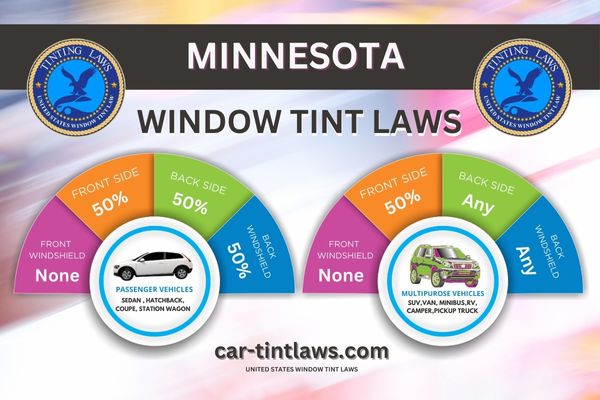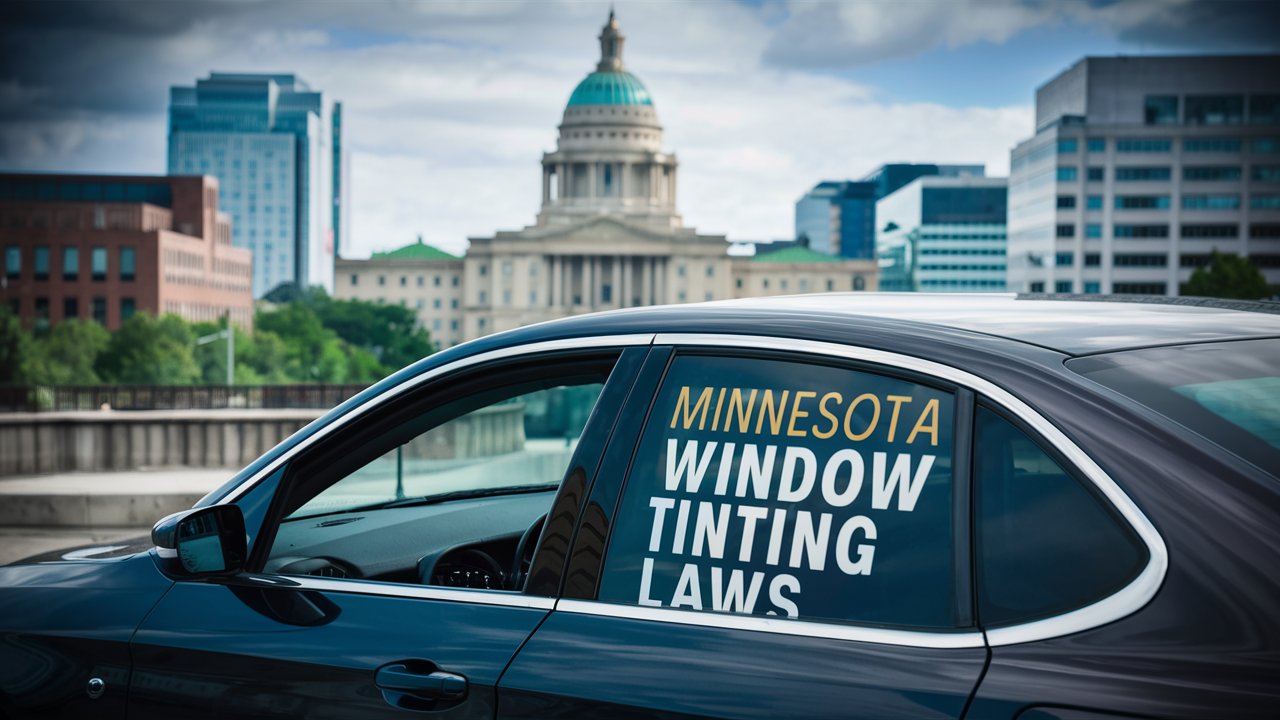If you’ve ever wondered about the specifics of Minnesota’s window tinting laws, you’re not alone.
It’s important to understand the legal limits on tint darkness and reflection to avoid penalties and guarantee road safety.
Did you know that different rules apply for sedans versus SUVs and vans? Plus, there are specific guidelines for medical exemptions and certification requirements for tint films.
Knowing these regulations isn’t just about compliance; it’s about maintaining visibility and safety for everyone on the road.
So, how do you confirm your vehicle meets these standards?
Window Tint Darkness in Minnesota
When it comes to window tint darkness in Minnesota, different rules apply to sedans, SUVs, and vans.
For sedans, both the front and rear side windows must allow more than 50% of light to pass through.
SUVs and vans have the same requirement for the front side windows, but there are no specific light allowances for their back side and rear windows.
Tint darkness for sedans:
- Windshield: Non-reflective tint is allowed on the top 5 inches of the windshield.
- Front Side windows: Must allow more than 50% of light in.
- Back Side windows: Must allow more than 50% of light in.
- Rear Window: Must allow more than 50% of light in.
Tint darkness for SUV and Vans:
- Windshield: Non-reflective tint is allowed on the top 6 inches of the windshield.
- Front Side windows: Must allow more than 50% of light in.
- Back Side windows: Any shade can be used.
- Rear window: Any shade can be used.
Window Tint Reflection in Minnesota
When it comes to window tint reflection in Minnesota, you’ll need to know the specific regulations for sedans and SUVs. Both types of vehicles must adhere to a maximum visible light reflectance (VLR) of 20%, making sure that reflective window films don’t cause excessive glare. These rules are in place to promote road safety and adhere to state laws.
Tint reflection for sedans:
- Front Side windows: Must not be more than 20% reflective.
- Back Side windows: Must not be more than 20% reflective.
Tint reflection for SUV and vans:
- Front Side windows: Ensure that your SUV or van’s window tint doesn’t exceed 20% reflection to comply with Minnesota’s legal guidelines.
- Back Side windows: The reflection limit is measured by visible light reflectance (VLR) to ensure safety and visibility on the road.
- Reflective films: Reduce glare and make driving more comfortable, but they must adhere to the maximum 20% VLR limit set by Minnesota law.
- Visibility and Safety: Maintaining proper reflection levels safeguards visibility for you and others on the road, preventing dangerous situations.
- Compliance: Following the state’s guidelines on tint reflection avoids penalties and ensures vehicle compliance with regulations.
- Choosing Window Tint: Always check the VLR percentage to verify it meets the state’s requirements for a safer driving environment.
- Community Responsibility: Attention to detail fosters a sense of community and responsibility among Minnesota drivers for a safer road experience.
Other Minnesota window tint rules and regulations
- Side Mirrors: No restrictions.
- Restricted Colors: In Minnesota, all tint colors are permitted.
- Certificates: Manufacturers of film need to certify the film they sell in the state. Ask your dealer if they are using certified film.
- Stickers: The sticker/label of compliance to identify legal tinting is required between the film & glass on each tinted window.
- Medical Exceptions: Minnesota permits medical exemptions for special tint. For more details about the specific terms of the exemption, consult MN state law.
- Penalties: Maximum fines for illegal tint in Minnesota can vary, with potential costs reaching hundreds of dollars. It’s crucial to adhere to the state regulations to avoid fines and legal consequences.

Medical Exemptions for Window Tint Rules in Minnesota
For those with specific medical conditions, Minnesota allows exceptions to standard window tinting regulations, provided you carry a medical note from your healthcare provider.
These medical exceptions enable you to use window tints that exceed the legal limits set by the State, helping manage conditions such as migraines or skin disorders.
This flexibility ensures that your health needs are accommodated while maintaining road safety.
To qualify for a medical exception, all you need is a medical note from your healthcare provider. Minnesota doesn’t require a formal application process for this exception.
Simply carrying the medical note in your vehicle can serve as proof for law enforcement officers if you’re ever questioned about your window tints. It’s important to keep this document readily accessible to avoid any legal issues.
Minnesota Window Tint Ticket Cost
If you violate Minnesota’s window shade laws, you could face a ticket costing up to $100 for the first offense. This window shade violation can be more than just a financial hit; it often comes with a fix-it ticket, requiring you to remove the non-compliant tint. The law is designed to balance personal preferences with safety concerns, ensuring that drivers have adequate visibility and law enforcement can clearly see inside vehicles.
Medical exemptions are available for those who need darker tint due to specific health conditions. If you qualify for a medical exemption, you need to carry the necessary documentation to avoid penalties. It’s essential to understand these regulations to avoid fines and guarantee everyone’s safety on the road.
Staying informed about Minnesota’s window shading laws can help you avoid unnecessary fines.
By complying with the legal standards, you’re contributing to safer driving conditions and adhering to state regulations.
Remember, while personalizing your vehicle is important, adhering to safety and legal requirements is vital.
Always check for any updates or changes in the law to stay compliant and avoid getting a window shade violation ticket.
Minnesota Vehicle Regulations Overview
In understanding Minnesota’s vehicle regulations, you’ll need to know the legal limits on window tinting, which vary by vehicle type and window location.
Ensuring safety and compliance is essential, as specific tint percentages are mandated to maintain visibility and reduce hazards.
Enforcement is strict, with penalties for violations ranging from fix-it tickets to fines up to $100 for first-time offenders.
Tinting Legal Limits
Minnesota’s window tinting laws stipulate that sedans, SUVs, and vans must have front side windows allowing over 50% light transmission.
This requirement guarantees that enough light passes through the windows, promoting visibility and safety.
For sedans, both front and back side windows must adhere to this 50% light transmission rule.
However, SUVs and vans have a bit more flexibility; while their front side windows must also allow more than 50% light transmission, the back side and rear windows do not have specific light transmission requirements.
This flexibility can be particularly beneficial if you need to tint your rear windows for privacy or to reduce glare.
It’s important to note that window tinting for windshields is strictly prohibited in Minnesota.
This regulation is in place to ensure the driver has an unobstructed view of the road.
Violating Minnesota’s tinting laws can result in penalties, including fines, which underscores the importance of adhering to these standards.
By following these guidelines, you not only stay compliant but also contribute to safer driving conditions.
Always check that any tint applied to your vehicle meets Minnesota’s legal limits to avoid any issues.
Safety and Compliance
Ensuring driver visibility and road safety is the primary goal of Minnesota’s vehicle regulations, including window tinting laws.
These laws are designed to manage the tint levels on your vehicle’s windows to prevent safety concerns that arise from poor visibility.
For instance, sedans in Minnesota must have front and rear windows that allow more than 50% light transmission.
While SUVs have specific requirements only for the front windows, ensuring that drivers can see pedestrians, cyclists, and other vehicles clearly.
Dark window tint can hinder your ability to notice crucial details, posing safety concerns during emergency situations and accidents.
It’s important for you to comply with these regulations to avoid fines and contribute to safer roads for everyone.
Compliance means adhering to specific light transmission percentages, which helps maintain driver visibility and reduces the risk of accidents.
Lt. Zak emphasizes that the primary purpose of window tint regulations in Minnesota is for safety, not to restrict personal style choices.
By following these window tinting laws, you’re not only adhering to the law but also ensuring that you, your passengers, and other road users remain safe.
Enforcement and Penalties
Frequently, drivers in Minnesota face enforcement actions for violating window tinting laws, which can lead to various penalties depending on the county.
Law enforcement officers conduct regular compliance checks to verify that vehicles meet the state’s window tinting regulations.
These checks are vital for maintaining road safety and visibility for all drivers.
If you’re caught with excessive tint, you’ll be cited for an equipment violation rather than a moving violation.
The penalties can vary by county, so it’s important to stay updated on local regulations.
Remember, as the driver, you’re responsible for confirming your vehicle complies with tinting laws, not the tinting business that applied the film.
In some cases, you might have a medical condition that requires darker tint. If so, law enforcement officers may request to see a prescription that allows for tint beyond the legal limits.
This prescription should be kept in your vehicle at all times to avoid penalties.
Lt. Zak emphasizes that these tinting laws focus on safety, not restricting your style choices.
Confirming your vehicle’s windows allow the required amount of visible light helps keep you and others safe on the road.
Compliance is key to avoiding unnecessary fines and ensuring everyone’s well-being.
References
Minnesota Statutes section 169.71: Windshield
Frequently Asked Questions
What Is the Darkest Legal Tint in Mn?
You’ll want to know that the darkest legal tint is 50% for sedan and SUV front side windows.
This guarantees safety and visibility while balancing sunlight, heat reduction, and privacy within legal limits and regulations.
Can You Get Pulled Over for Tint in Minnesota?
Imagine cruising down a sunny Minnesota road, only to see flashing lights behind you.
Yes, you can get pulled over for tint legality violations. Officers conduct tint inspections; non-compliance can lead to fines and safety concerns.
How Much Is a Tint Ticket in Minnesota?
You’re wondering about tint fines in Minnesota? A tint ticket for violating tint regulations can cost up to $100 for a first offense.
Guarantee your tint application meets tint visibility standards to avoid penalties.
How to Get a Tint Exemption in Minnesota?
To get a tint exemption, you’ll need proof of medical conditions. Obtain legal documentation from your healthcare provider for police discretion.
This allows vehicle modifications for your health needs without formal applications, ensuring you belong on the road.
Conclusion
By understanding and adhering to Minnesota’s window tinting laws, you’ll guarantee safer driving conditions, avoid legal penalties, and maintain visibility for all road users.
Remember to follow the specific regulations for tint darkness, reflection, and medical exemptions.
Be certain your tint films are properly certified and display the required compliance stickers on your vehicle windows.
Compliance with these rules not only promotes safety but also helps you stay within the legal framework, contributing to overall road safety.
